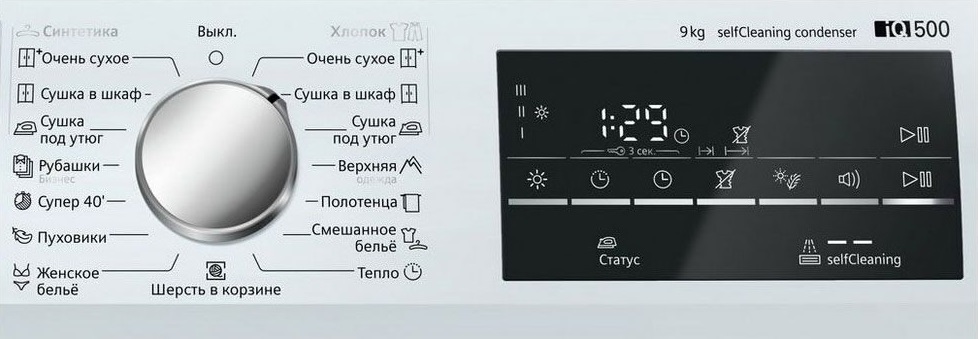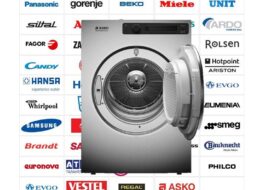Do I need to iron my clothes after drying them in the dryer?
 When automatic washing machines were invented, it became a real revolution for a huge number of housewives. Then, along with washing machines, dryers appeared, saving people all over the world from the need to dry clothes on the balcony or in the apartment for days. But people get used to everything, and now people are asking for an automatic ironing machine, so as not to have to worry about using the iron after washing and drying. However, there are those who claim that there is no need to iron clothes after drying if you put things in the drum correctly. Let's check if this is actually true.
When automatic washing machines were invented, it became a real revolution for a huge number of housewives. Then, along with washing machines, dryers appeared, saving people all over the world from the need to dry clothes on the balcony or in the apartment for days. But people get used to everything, and now people are asking for an automatic ironing machine, so as not to have to worry about using the iron after washing and drying. However, there are those who claim that there is no need to iron clothes after drying if you put things in the drum correctly. Let's check if this is actually true.
A tumble dryer is no substitute for an iron.
We should pay tribute to the manufacturers of drying machines; they really add more and more new modes to the units, which allow you to use the iron to a minimum after drying, but, unfortunately, they do not replace full ironing. Some items really do not need ironing after automatic drying, but this is more likely a merit of the fabric rather than the dryer.
There are two basic rules for making things less wrinkled after drying: the first is to choose the right mode depending on the type of fabric and the second is to maintain a load balance. If you spread things out spaciously in the drum and smooth them out thoroughly, they will dry well and hardly become wrinkled. But if you knock the clothes into a tight ball and load the drum to capacity, the clothes will dry worse and will be very wrinkled.
Attention! Programs such as “Iron” or “Closet” will help reduce creasing in the dryer to a minimum.
Special modes have almost no mechanical effect on laundry, but only actively blow hot air onto stacks of clothes.
It is also not recommended to leave clothes in the dryer after the end of the cycle. The longer it lies there, the more difficult it will be to iron it later, as it will cool down and become frosty. While the laundry is still warm, just shake it to get it into shape (you can do without an iron). If there are any wrinkles, it will be easier to iron them out than with a cooled fabric.
Rules for using the dryer
If your clothes come out of the dryer wrinkled, it's not a big deal. It is much worse when, during the drying process, the product is irreversibly damaged due to the user’s carelessness. Most often this happens when things that cannot be dried automatically are placed in the dryer. As a rule, these are things that cannot withstand strong mechanical stress and high temperatures. Among them:
- very thin materials, for example, lace, cambric, tulle;
- richly decorated products, especially with embroidery, appliqués, metal stripes and other elements;
- nylon, nylon and other polyamide fabrics.

Particular care should be taken when drying multi-layered items that dry unevenly, such as parkas, down jackets, feather duvets and pillows. Some users manage to dry such things automatically using a combination of modes: first, ultra-high-speed drying, and then warm blowing at the final stage of the cycle. However, unfortunately, not every automatic dryer is equipped with suitable functions and programs, so you need to carefully listen to the manufacturers' instructions.Some dryers claim to be suitable for drying pillows, blankets and jackets, while others do not.
When loading the dryer, do not forget that ordinary new knitted items can shrink due to high temperatures. So if you bought a T-shirt or a set of underwear, it will be easier to dry it naturally than to face catastrophic shrinkage later. The same thing, even to a greater extent, applies to woolen items. If you resort to automatic drying of all these products, opt for the most delicate modes.
Important! Here's what automatic drying won't harm and what it can really replace an iron with is synthetic fabrics.
Along with synthetics, only some cotton items have this property: after drying them in the machine, you can either immediately put them on or put them in the closet.
As mentioned above, it is imperative to maintain balance when loading the dryer. Most units are designed for a load of 5-7 kg, but there are also compact machines in which you can dry no more than 3.5 kg of laundry. It should be borne in mind here that the weight of dry items is always indicated, not wet. In addition, these indicators are completely relevant only for items made of cotton and linen. In the case of synthetics, for example, the permissible volume can be halved, and with wool, the drum load should not exceed 1 kg at all. Of course, you shouldn’t cut one woolen sweater into several pieces if it weighs a little more, but you shouldn’t load the rest of the things into the machine.
Overloading the drum can harm not only the dryer itself, but also the things inside and the quality of drying. The more clothes you stuff into the drum, the worse they dry out and the more wrinkled they become.Experienced users, for this reason, recommend drying, for example, blouses and shirts in very small quantities, regardless of the type of fabric.
Everyone is accustomed to the fact that before putting them in the washing machine, things need to be sorted by color and type of fabric; the dryer also requires sorting, but only by the degree of humidity and the desired degree of drying. It can also be helpful to sort by size so that, for example, socks or underwear don't get caught inside pillowcases and duvet covers. As a last resort, fasten all zippers and buttons on large items.
And the last rule - do not forget to check the laundry for the presence of foreign elements before putting it in the dryer. Some plastic hooks or other parts may melt or stain other items when exposed to high temperatures. It is better to either take out the underwires from the bras or sew them on. It is better to tie the straps of aprons and swimsuits.
Interesting:
Reader comments
- Share your opinion - leave a comment




















Add a comment